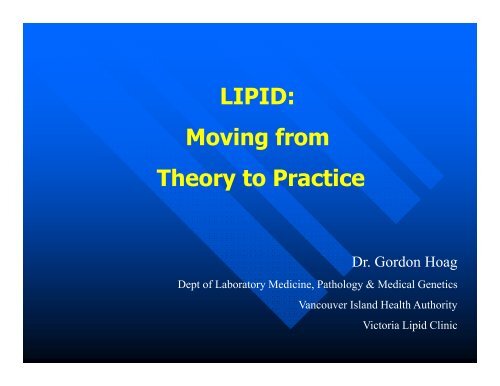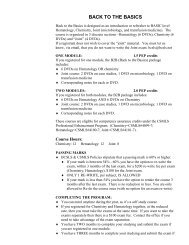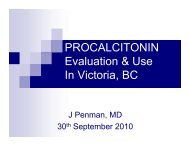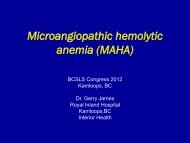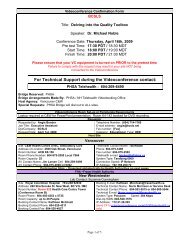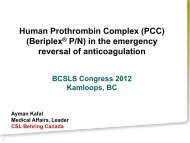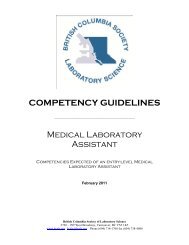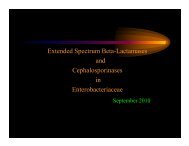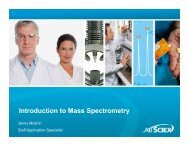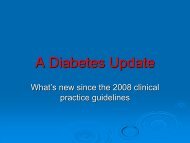LIPID - the British Columbia Society of Laboratory Science
LIPID - the British Columbia Society of Laboratory Science
LIPID - the British Columbia Society of Laboratory Science
You also want an ePaper? Increase the reach of your titles
YUMPU automatically turns print PDFs into web optimized ePapers that Google loves.
<strong>LIPID</strong>:<br />
Moving from<br />
Theory to Practice<br />
Dr. Gordon Hoag<br />
Dept <strong>of</strong> <strong>Laboratory</strong> Medicine, Pathology & Medical Genetics<br />
Vancouver Island Health Authority<br />
Victoria Lipid Clinic
Disclosure Information<br />
<br />
Honoraria for presentations from Merck Frosst, Schering, Pfizer,<br />
AstraZeneca, Fournier and Roche.<br />
<br />
A member <strong>of</strong> scientific advisory boards from AstraZeneca, Schering,<br />
Merck Frosst, Oryx Pharma and Beckman Coulter.<br />
<br />
A recipient <strong>of</strong> unrestricted educational grants from Merck Frosst and<br />
AstraZeneca.<br />
<br />
A recipient <strong>of</strong> research grants from Merck Frosst, San<strong>of</strong>i, Pfizer and<br />
GlaxoSmithKline.
Mean Total Cholesterol mg/dL<br />
200<br />
180<br />
160<br />
140<br />
120<br />
100<br />
80<br />
60<br />
40<br />
20<br />
0<br />
Hazda !Kung San Howler<br />
Monkey<br />
Horse Peccary African<br />
Elephant<br />
Hunter-Ga<strong>the</strong>rer Humans Wild Primates Wild Mammals Modern Human
What is a logical approach?
Extra Hepatic<br />
Organs<br />
Net Cholesterol Balance in Humans<br />
Liver<br />
Intestine<br />
Dietary Cholesterol<br />
(400 mg/day)<br />
LDL<br />
VLDL<br />
Cholesterol<br />
LDLR<br />
Cholesterol<br />
1200 mg/day<br />
(cholesterol+bile acids)<br />
Cholesterol<br />
Acetyl-CoA<br />
ABCA1<br />
HDL<br />
Acetyl-CoA<br />
SRB1<br />
800 mg/day<br />
Syn<strong>the</strong>sized Cholesterol<br />
(400 mg/day)<br />
Fecal Sterols<br />
(800 mg/day)<br />
Courtesy Dr Murray Huff
M24<br />
Ezetimibe : Mechanism <strong>of</strong> Action<br />
Apo B 48<br />
CE Poor<br />
Chylomicron<br />
ABCG5/G8<br />
ACAT<br />
NPC1L1<br />
Protein<br />
X<br />
Less free<br />
cholesterol<br />
& sterol<br />
absorption<br />
Intestinal Lumen<br />
EZETIMIBE<br />
Enterocyte<br />
Lymphatic Vessel<br />
Ezetimibe has specific, high affinity binding<br />
to a structural protein on <strong>the</strong> brush border
Slide 6<br />
M24<br />
same<br />
Merck, 07/02/2008
POSCH-Study<br />
Program on <strong>the</strong> Surgical Control <strong>of</strong> <strong>the</strong> Hyperlipidemia<br />
*5 years after randomization<br />
"The POSCH trial provides long-term evidence supporting<br />
effective lipid modification in <strong>the</strong> management <strong>of</strong> a<strong>the</strong>rosclerosis"<br />
n=421 Follow up = 14.7 years<br />
Influence on Lipids*:<br />
Total cholesterol:<br />
LDL-C<br />
HDL-C<br />
Reduction <strong>of</strong> Endpoints:<br />
Total mortality:<br />
CHD-mortality:<br />
PTCA/Bypass<br />
- 23 %, p
hs-CRP Adds to Predictive Value <strong>of</strong> TC:HDL<br />
Ratio in Determining Risk <strong>of</strong> First MI<br />
5.0<br />
4.0<br />
Relative Risk<br />
3.0<br />
2.0<br />
1.0<br />
0.0<br />
High Medium Low Low<br />
Total Cholesterol:HDL-C Ratio<br />
Medium<br />
High<br />
Ridker et al, Circulation 1998;97:2007–2011.
JUPITER: Evidence supporting pharmacological<br />
intervention in medium risk patients<br />
Primary Endpoint: Time to first occurrence <strong>of</strong> a CV death, non-fatal stroke, non-fatal MI,<br />
unstable angina or arterial revascularization<br />
Cumulative incidence<br />
0.08<br />
0.06<br />
0.04<br />
0.02<br />
0.00<br />
N at risk<br />
Rosuvastatin<br />
8,901<br />
Placebo<br />
8,901<br />
HR 0.56 (95% CI 0.46 – 0.69)<br />
P < 0.00001<br />
0 1 2 3 4<br />
Follow-up (years)<br />
8,631<br />
8,621<br />
8,412<br />
8,353<br />
6,540<br />
6,508<br />
3,893<br />
3,872<br />
1,958<br />
1,963<br />
1,353<br />
1,333<br />
Placebo<br />
251 / 8,901<br />
Ridker P et al. Rosuvastatin to prevent vascular events in men and women with elevated C-<br />
reactive protein.N Engl J Med 2008; 359: 2195-207<br />
983<br />
955<br />
544<br />
534<br />
Rosuvastatin 20<br />
mg<br />
142 / 8,901<br />
157<br />
174<br />
RRR<br />
-44%<br />
LDL reduction 50%
Evidence favouring LDL reduction for <strong>the</strong> prevention and<br />
treatment <strong>of</strong> a<strong>the</strong>rosclerosis is strong and compelling<br />
A prospective meta-analysis <strong>of</strong> data from 90,056 individuals from 14 trials <strong>of</strong> statins 1<br />
A 1 mmol/L (39 mg/dL) reduction in LDL-C was associated with a…<br />
50<br />
23% reduction in<br />
major coronary events<br />
50<br />
21% reduction in<br />
major vascular events<br />
40<br />
40<br />
Proportional reduction in<br />
event rate (%±SE)<br />
30<br />
20<br />
10<br />
0<br />
-10<br />
0.5<br />
(19)<br />
1.0<br />
(38)<br />
Reduction in<br />
LDL-C mmol/L (mg/dL)<br />
1.5<br />
(58)<br />
2.0<br />
(77)<br />
Proportional reduction in<br />
event rate (%±SE)<br />
30<br />
20<br />
10<br />
0<br />
-10<br />
0.5<br />
(19)<br />
1.0<br />
(38)<br />
1.5<br />
(58)<br />
Reduction in<br />
LDL-C mmol/L (mg/dL)<br />
2.0<br />
(77)<br />
Adapted from Baigent C, et al, Cholesterol Treatment Trialists’ (CTT) Collaborators. Lancet<br />
2005;366:1267–1278.
CD1<br />
Nonfatal MI and CHD death RR reduction (%)<br />
Multiple studies showed a relationship between<br />
LDL-C Reduction & CHD relative risk<br />
100<br />
80<br />
60<br />
40<br />
20<br />
0<br />
-20<br />
London<br />
Oslo<br />
MRC<br />
Los Angeles<br />
Upjohn<br />
LRC<br />
NHLBI<br />
POSCH<br />
4S<br />
WOSCOPS<br />
CARE<br />
<strong>LIPID</strong><br />
AF/TexCAPS<br />
HPS<br />
ALERT<br />
PROSPER<br />
ASCOT-LLA<br />
CARDS<br />
15 20 25 30 35 40<br />
LDL-C reduction (%)<br />
Adapted with permission from Robinson et al. JACC 2005; 46:1855-62
Slide 16<br />
CD1 Even when looking at <strong>the</strong> original slide Dr Ftichett sent, I still can't find where London is ?????<br />
Charles Dupont, 05/03/2008
Relationship Between Mean Low-Density Lipoprotein<br />
Cholesterol Levels and Median Change in Percent A<strong>the</strong>roma<br />
Volume for Several Intravascular Ultrasound Trials<br />
Nissen, S. E. et al. JAMA 2006;295:1556-1565.<br />
Copyright restrictions may apply.
Wide Variation <strong>of</strong> Response to Statins<br />
<br />
% LDL-C reduction to<br />
simvastatin or pravastatin up<br />
to 60 mg/d for 3 months<br />
Mean reduction 20%<br />
12% had LDL-C ↓
M19<br />
Individual LDL-C % Response<br />
to Atorvastatin 10mg<br />
% LDL-C change<br />
0<br />
-10<br />
-20<br />
-30<br />
-40<br />
-50<br />
0<br />
-10<br />
-20<br />
-30<br />
-40<br />
-50<br />
-60<br />
-70<br />
Men<br />
-60<br />
-70<br />
Women<br />
Pedro-Botet J et al. A<strong>the</strong>rosclerosis 2001; 158:183-93
Slide 22<br />
M19<br />
is author's name Pedro-Bolet or Botet.. need to check<br />
Merck, 07/02/2008
Limitations <strong>of</strong> Statin Mono-<strong>the</strong>rapy in<br />
Achieving LDL-Cholesterol Targets<br />
Attenuated dose response for LDL-C lowering<br />
» Largest effect at lowest dose<br />
» Doubling statin dose reduces LDL-C by ~5-6%<br />
Wide inter-individual variation <strong>of</strong> statin response<br />
Higher doses associated with increased toxicity<br />
» Hepatic<br />
» Musculoskeletal
The Majority <strong>of</strong> Statin LDL-C Efficacy<br />
is with <strong>the</strong> Starting Dose<br />
0<br />
Atorvastatin Rosuvastatin Simvastatin<br />
Mean % Change in LDL-C From<br />
Untreated Baseline<br />
-10<br />
-20<br />
-30<br />
-40<br />
-50<br />
-37%<br />
-6%<br />
-5%<br />
-3%<br />
-28%<br />
-46% *† -7%<br />
-4%<br />
-7%<br />
-6%<br />
-3%<br />
10mg<br />
20mg<br />
40mg<br />
80mg<br />
-60<br />
10 mg 20 mg 40 mg 80 mg<br />
Jones PH et al. Am J Cardiol 2003;92:152-60
Genetic Variants <strong>of</strong> NPC1L1 and Cholesterol Absorption<br />
<br />
Numerous rare protein<br />
variants <strong>of</strong> NPC1L1 exist in<br />
<strong>the</strong> patient population<br />
NPC1L1 Protein Variants<br />
<br />
The relationship between<br />
<strong>the</strong>se and both ezetimibe<br />
response and altered sterol<br />
absorption remains to be<br />
determined<br />
Huff et al ATVB 2006;26:2437
The Genetics <strong>of</strong> <strong>the</strong> Cholesterol Transport<br />
Protein, Neimann Pick C1 like 1 Protein, in <strong>the</strong><br />
Intestine<br />
Eight genetic variants described<br />
Variants have a pharmacological effect on<br />
response<br />
Normal variant (60% <strong>of</strong> <strong>the</strong> population) has<br />
a 15-25% response<br />
Non-responders and hyper-responders are<br />
expected<br />
Two week course <strong>of</strong> Ezetimibe is<br />
informative to <strong>the</strong> genetics <strong>of</strong> <strong>the</strong> patient
Case 1<br />
<br />
M.M. 43 y.o., <strong>British</strong> Origin, Photographer, Married, 1 son<br />
Identified high cholesterol 15 years ago, Fa<strong>the</strong>r age 65<br />
died.<br />
AMI recently (2004)<br />
<br />
<br />
<br />
<br />
<br />
On Lipitor severe jaundice.<br />
Several episodes <strong>of</strong> chest pain. No L arm radiation<br />
No: DM, HBP, TIA’s, PVD.<br />
Exercise level very high<br />
Alcohol: wine/beer. 2-6 oz/wk
Case 1 continued<br />
On examination: Arcus Bilaterally, Tendons<br />
thickened, abdominal girth 89.5 cm, height<br />
5’6”, and weight 175 lbs<br />
Lab Value Initial 6 wk Ezetrol<br />
<br />
– TG(mmol/L) 3.92 1.52<br />
– Chol(mmol/L) 8.27 6.47<br />
– LDL(mmol/L) 5.6 4.1<br />
– HDL(mmol/L) 0.93 0.94<br />
Dx F.H.
Benefit from LDL-C reduction<br />
independent <strong>of</strong> mechanism<br />
31
Pharmaco<strong>the</strong>rapy (LDL Cholesterol):<br />
Immediate treatment for high-risk patients<br />
Concomitant diet and lifestyle changes<br />
Statin mono<strong>the</strong>rapy<br />
Moderate risk patients:<br />
- Initiate health behavior interventions<br />
- Pharmacological treatment is indicated if:<br />
LDL-C >3.5 mmol/L<br />
TC/HDL-C ratio >5.0<br />
Hs-CRP > 2 mg/L in men older than 50 years and in<br />
women older than 60 years <strong>of</strong> age, irrespective <strong>of</strong><br />
LDL-C<br />
Genest J et al: 2009 Canadian Cardiovascular <strong>Society</strong>/Canadian guidelines for <strong>the</strong> diagnosis and<br />
treatment <strong>of</strong> dyslipidemia and prevention <strong>of</strong> cardiovascular disease in <strong>the</strong> adult- 2009<br />
recommendations. Can J Cardiol 2009; 25(10): 567-579..
Pharmaco<strong>the</strong>rapy (LDL Cholesterol):<br />
Significant minority <strong>of</strong> patients will require combination <strong>the</strong>rapy<br />
• Ezetimibe (inhibits cholesterol absorption)<br />
Additional LDL-C reductions <strong>of</strong> up to 20%<br />
• Bile acid sequestrants (inhibits bile acid reabsorption)<br />
Additional LDL-C reductions <strong>of</strong> 10-15%<br />
• Niacin<br />
Additional LDL-C reductions <strong>of</strong> up to 20%<br />
Combinations are generally safe<br />
Clinical outcome trials underway
Optional Secondary Targets when LDL-C at Target<br />
Test Cut-point Intervention<br />
TC/HDL-C >4.0 Fibrate<br />
Niacin<br />
Non HDL-C >3.5 mmol/L Fibrate<br />
Niacin<br />
Apo B/AI >0.8 Ezetimibe<br />
Niacin<br />
Triglycerides >1.7 mmol/L Fibrate<br />
Niacin<br />
hsCRP >2.0 mg/L Ezetimibe<br />
Statin<br />
Adjusting lipid-lowering <strong>the</strong>rapy to optimize one or more <strong>of</strong> <strong>the</strong>se<br />
secondary targets may be considered in <strong>the</strong> high risk patient, after<br />
achieving a target LDL-C or ApoB, but <strong>the</strong> clinical advantages <strong>of</strong> this<br />
approach, with respect to patient outcomes, remain to be proven.<br />
Genest J et al: Can J Cardiol 2009; 25(10): 567-579.
Important Take Home Points<br />
<br />
<br />
<br />
Evidence favouring LDL reduction for <strong>the</strong><br />
prevention and treatment <strong>of</strong> a<strong>the</strong>rosclerosis<br />
is strong and compelling<br />
New guidelines recommend a more<br />
aggressive approach to management <strong>of</strong> both<br />
high and medium risk patients<br />
– Target LDL-C
CASE STUDY<br />
A 63yo male diabetic patient was referred to <strong>the</strong> Victoria<br />
Lipid Clinic in October 2008. An appointment was made<br />
for May 2009.
Test Range Results:<br />
Sep-08<br />
TRIG
What would you do?<br />
- Fur<strong>the</strong>r analysis<br />
- Intervention<br />
- What are <strong>the</strong> targets?<br />
- O<strong>the</strong>r clinical findings<br />
- O<strong>the</strong>r diagnosis<br />
- Would you have considered this an “Urgent” referral?
Test Range Results:<br />
Apr-09<br />
TRIG
What would you do?<br />
- Fur<strong>the</strong>r analysis<br />
- What are <strong>the</strong> targets?
Test Range Results:<br />
Jul-09<br />
TRIG
What would you do?<br />
- Fur<strong>the</strong>r analysis
Test Range Results:<br />
Aug-09<br />
TRIG
What is <strong>the</strong> appropriate target?
Risk Categories and Treatment<br />
Recommendations
What is A<strong>the</strong>rogenic Dyslipidemia?<br />
Normal ratio <strong>of</strong> VLDL<br />
to LDL particles in<br />
plasma<br />
A<strong>the</strong>rogenic<br />
dyslipidemia –<br />
increased VLDL and<br />
sd-LDL<br />
VL<br />
DL<br />
apo<br />
B<br />
sd-<br />
LDL<br />
norm<br />
al<br />
LDL<br />
adapted from:<br />
Sniderman et al<br />
CMAJ Jan 9 2001; 164 (1)
Mortality in Statin Secondary Prevention Trials<br />
Mortality (%)<br />
10<br />
9<br />
8<br />
7<br />
6<br />
5<br />
4<br />
3<br />
2<br />
1<br />
0<br />
4S<br />
S40<br />
4S<br />
PL<br />
CARE<br />
P40<br />
CARE<br />
PL<br />
<strong>LIPID</strong><br />
P40<br />
<strong>LIPID</strong><br />
PL<br />
HPS<br />
S40<br />
HPS<br />
PL<br />
non-CV<br />
CV<br />
TNT<br />
A80<br />
TNT<br />
A10
Individual LDL-C Response to Ezetimibe 10mg<br />
% change in LDL-C mmol/L<br />
20<br />
10<br />
0<br />
-10<br />
-20<br />
-30<br />
-40<br />
-50<br />
-60<br />
-70<br />
-80<br />
haplotype 2<br />
mean = -23.6±1.6%<br />
P=0.0054<br />
non haplotype 2<br />
mean = -35.9±4.0%<br />
Subjects with NPC1L1 haplotype 2<br />
(1735C-25342A-27677T)<br />
Subjects not carrying NPC1L1 haplotype 2<br />
Hegele RA et al. Lipids in Health and Disease 2005; 4:16
Effects <strong>of</strong> Ezetimibe as Mono or Combination Therapy over Any Time Frame on<br />
Total Cholesterol in 141 Patients at <strong>the</strong> Victoria Lipid Clinic<br />
100%<br />
Fig 1: Total Cholesterol (A) and LDL-c (B) response and <strong>the</strong>rapeutic catagories for individual patients<br />
80%<br />
Percent Change in Total Cholesterol<br />
60%<br />
40%<br />
20%<br />
0%<br />
-20%<br />
-40%<br />
Individual Patients<br />
Non-effective<br />
Non-Responsive<br />
Minimally Responsive<br />
Moderately Responsive<br />
Hyper-Responsive
Does one size fit all?
Unimodel for Cholesterol Metabolism<br />
Syn<strong>the</strong>sizers Mixed Absorbers<br />
Hoenig MR, et al. A<strong>the</strong>rosclerosis 184 (2006) 247-254<br />
Miettinen TA, et al. A<strong>the</strong>rosclerosis 164 (2002) 147-152
Reciprocal Model for Cholesterol Metabolism<br />
Absorbers<br />
S<br />
y<br />
n<br />
t<br />
h<br />
e<br />
s<br />
i<br />
z<br />
e<br />
r<br />
s<br />
Low Moderate High<br />
High Moderate Low<br />
Santosa S, et al. Life <strong>Science</strong>s xx (2006) xxx-xxx<br />
Harats D. XIV Int’l Symposium on A<strong>the</strong>rosclerosis 2006 Rome, Italy
Matrix Model for Cholesterol Metabolism<br />
Absorbers<br />
S<br />
y<br />
n<br />
t<br />
h<br />
e<br />
s<br />
i<br />
z<br />
e<br />
r<br />
s<br />
Low<br />
Low<br />
Low<br />
Moderate<br />
Low<br />
High<br />
Moderate<br />
Low<br />
Moderate<br />
Moderate<br />
Moderate<br />
High<br />
High<br />
Low<br />
High<br />
Moderate<br />
High<br />
High
Percent Reduction in LDL by Statin negatively<br />
correlates to percent reduction by Ezetimibe<br />
80<br />
% reduction in LDL-C by ezetimibe<br />
60<br />
40<br />
20<br />
0<br />
-20<br />
r = -0.29, p = 0.002<br />
-20 0 20 40 60 80<br />
% reduction in LDL-C by statin<br />
Senaratne et al. Am Coll Cardiol, New Orleans March 2007
Effects <strong>of</strong> Ezetimibe Co-Administered with Statin on<br />
Cholesterol Production, LDL-R Expression and LDL-C<br />
Levels<br />
Theoretical response<br />
Relative change<br />
Cholesterol Production<br />
Inhibitor (Statin)<br />
Cholesterol Absorption<br />
Inhibitor (Ezetimibe)<br />
Cholesterol Absorption<br />
Inhibitor (Ezetimibe)<br />
+<br />
Cholesterol Production<br />
Inhibitor (Statin)<br />
Content Syn<strong>the</strong>sis<br />
LDL-R<br />
LDL-C<br />
Content Syn<strong>the</strong>sis<br />
LDL-R<br />
LDL-C<br />
Content Syn<strong>the</strong>sis<br />
LDL-R<br />
LDL-C<br />
Turley S.D. and Dietschy J.M., Preventive Cardiology 2003; Vol VI
Baseline Cholesterol Syn<strong>the</strong>sis as a Predictor <strong>of</strong><br />
Recurrent Coronary Events and Response to Statins<br />
Risk reduction with simvastatin not associated<br />
with baseline cholesterol<br />
? Is reduction <strong>of</strong> risk related to<br />
– Baseline intestinal absorption<br />
– Baseline endogenous cholesterol syn<strong>the</strong>sis<br />
4S Sub-study in 866 subjects<br />
Measured Cholestanol / Cholesterol<br />
– Index <strong>of</strong> absorption / syn<strong>the</strong>sis<br />
Miettinen et al. BMJ 1998; 316:1127
Simvastatin Did Not Reduce Major Coronary Events in <strong>the</strong><br />
Highest Quartiles <strong>of</strong> Cholesterol Absorption - 4S Sub-Study<br />
40<br />
38%<br />
34% 25% 17%<br />
Relative Risk<br />
% Major coronary events<br />
35<br />
30<br />
25<br />
20<br />
15<br />
10<br />
5<br />
Placebo (n=434)<br />
Simvastatin<br />
20-40 mg (n=434)<br />
0<br />
1 2 3 4<br />
Low Cholesterol<br />
Absorption<br />
4S = Scandinavian Simvastatin Survival Study.<br />
High Cholesterol<br />
Absorption<br />
Miettinen et al. BMJ 1998; 316:1127
Achievement <strong>of</strong> target LDL-C concentrations:<br />
In high risk individuals, treatment should be<br />
started immediately, concomitant with diet and<br />
<strong>the</strong>rapeutic lifestyle changes. The primary target<br />
<strong>of</strong> <strong>the</strong>rapy is to achieve an LDL-C level <strong>of</strong> less<br />
than 2.0 mmol/L. For patients with established<br />
CAD, a reduction <strong>of</strong> LDL-C <strong>of</strong> at least 50% is<br />
generally required to prevent progression or elicit<br />
regression <strong>of</strong> a<strong>the</strong>rosclerosis.
Target lipid levels:<br />
The majority <strong>of</strong> patients, including those with<br />
<strong>the</strong> metabolic syndrome, diabetes mellitus and<br />
combined dyslipidemia, are able to achieve<br />
target levels <strong>of</strong> LDL-C on statin mono<strong>the</strong>rapy.<br />
However, a significant minority <strong>of</strong> patients may<br />
require combination <strong>the</strong>rapy with an agent that<br />
inhibits cholesterol absorption (ezetimibe) or<br />
bile acid reabsorption (cholestyramine).
Ezetimibe and Cholesterol Balance<br />
Conclusions<br />
<br />
<br />
<br />
<br />
<br />
<br />
<br />
LDL-C response to both statins and ezetimibe is variable<br />
A possible contributor might be <strong>the</strong> wide range <strong>of</strong> intestinal cholesterol absorption<br />
Genetic variation appears to underlie <strong>the</strong> intestinal cholesterol absorption, ranging<br />
from high to usual to low<br />
Ezetimibe inhibits 17% (average) <strong>of</strong> intestinal cholesterol uptake (50% in animal<br />
studies)<br />
Variation in response to ezetimibe might reflect genetic difference in intestinal<br />
absorption and /or expression <strong>of</strong> NPC1L1<br />
High intestinal absorption might be associated with reduced syn<strong>the</strong>sis – and<br />
reduced response to statin<br />
Poor response to statin may be associated with enhanced response to ezetimibe,<br />
while enhanced response to statin might be associated with poor response to<br />
ezetimibe.
Risk Level<br />
Initiate Treatment if:<br />
High<br />
patients<br />
CAD, PVD<br />
A<strong>the</strong>rosclerosis<br />
2009 Target Lipid Levels<br />
Consider treatment in all<br />
Most Pts with Diabetes<br />
FRS>20%<br />
RRS>20%<br />
Moderate<br />
FRS 10-19% LDL-C>3.5 mmol/L<br />
TC/HDL > 5.0<br />
hsCRP > 2<br />
– men 50+, women 60+<br />
Family history and hsCRP modulate risk<br />
Low<br />
FRS 5.0 mmol/L<br />
Primary LDL-C<br />
< 2 mmol/L<br />
Or ≥ 50 % ↓ LDL-C<br />
< 2 mmol/L*<br />
Or ≥ 50% ↓ LDL-C<br />
≥ 50% ↓ LDL-C<br />
Primary<br />
Alternate<br />
Genest J et al: 2009 Canadian Cardiovascular <strong>Society</strong>/Canadian guidelines for <strong>the</strong> diagnosis and<br />
treatment <strong>of</strong> dyslipidemia and prevention <strong>of</strong> cardiovascular disease in <strong>the</strong> adult- 2009<br />
recommendations. Can J Cardiol 2009; 25(10): 567-579..<br />
ApoB < 0.80 g/L<br />
ApoB < 0.80 g/L
TRANSPORTERS<br />
Bailey KM. Cytochrome p450 variants and response to statin <strong>the</strong>rapy following Acute Coronary<br />
Syndrome. [PowerPoint Presentation – LIGHT Research Meeting]. 2007
DRUG TRANSPORTER GENETICS<br />
Influx Transporter<br />
– Organic Anion Transporter Polypeptide B1<br />
(SLCO1B1)<br />
Efflux Transporter<br />
– Breast Cancer Resistant Protein (BCRP)<br />
– Single Nucleotide Polymorphisms (SNP’S)<br />
» SLCO1B1 521 T>C<br />
» BCRP 421 C>A
SPACE ROCKET<br />
Evaluation<br />
– 630 patient clinical trial<br />
Rosuvastatin (10mg X 3mo)<br />
BCRP CC (249) BCRP CA/AA** (75)<br />
LDL-C 1.98mmol/L 1.78 mmol/L * *(p=0.012)<br />
SLCO1B1 TT<br />
SLCO1B1 TC/CC<br />
LDL-C 1.90 mmol/L 2.01 mmol/L<br />
**Note: The AA Genotype demonstrated an average <strong>of</strong> 20% reduction.<br />
Romaine SP, et al. AHA Abstract 3447: Circulation 2008;118:S_426
Statins<br />
Are effective in lowering cholesterol and<br />
have established a role in both secondary<br />
and primary prevention<br />
The response <strong>of</strong> an individual to a given<br />
statin can be determined within 6 weeks<br />
The SNP’s for transporter genes can effect<br />
<strong>the</strong> efficacy for certain statins<br />
The drug and liver metabolite may have<br />
different pharmacokinetic properties


